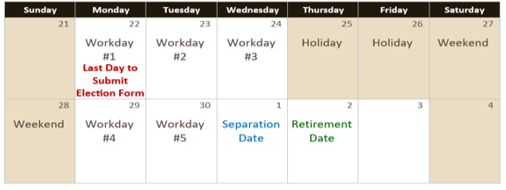Why consider contributing your Lump Sum Separation Pay?
Your Lump Sum Separation Pay isn’t just a final paycheck, it’s a unique opportunity to make a meaningful impact on your financial future.
Top benefits
How it works
Meet with your HR office
Estimate your leave balance and calculate the value of your Lump Sum Separation Pay.
Review IRS contribution limits
Understand how much you can contribute to your 401(k) and 457(b) plans, including catch-up options.
Complete the worksheet
Use the Lump Sum Separation Pay Workbook to calculate your eligible contributions.
Choose your strategy
Decide how to allocate your contributions across standard IRS limits, catch-up contributions (age-based or traditional), or two tax years (if separating in November or December).
Complete and submit your form
Turn in your completed form to your HR office at least 30 days before separation.
Let’s say you’re separating in December, and your estimated Lump Sum Separation Pay is $100,000. You’re age 59, so you qualify for Age-Based Catch-Up and Traditional Catch-Up. You want to maximize your contributions across two tax years.
Your strategy:
- 2025 Contributions
- $23,500 to 457(b) Standard
- $7,500 to 457(b) Age-Based Catch-Up
- $23,500 to 401(k) Standard
- $7,500 to 457(b) Age-Based Catch-Up
- 2026 Contributions
- $23,500 to 457(b) Standard (estimated)
- $14,500 to 457(b) Traditional Catch-Up (approval required)
This strategy allows you to defer the entire lump sum, reduce your taxable income, and maximize retirement savings.
Boost your retirement with Traditional Catch-Up (TCU)
If you're within three years of your planned retirement, the 457(b) Traditional Catch-Up provision offers a powerful way to maximize your retirement savings, especially when paired with your Lump Sum Separation Pay.
Why use TCU for your lump sum?
Guides and tools
Step-by-step instructions and worksheets to calculate your contributions
View current limits
Learn more about age-based and Traditional Catch-Up options
Access your leave balances and contribution history
Forms and resources
Are you a payroll specialist or HR representative?
For the most accurate leave balance estimate, contact your HR office, and they can provide the amount for you.
Submit your form at least 30 days before your separation date. It must be received no later than five workdays prior to separation.
Please note: effective October 24, 2025, your HR office will only accept the latest revision of the form, which you can find above.
Yes. If you're submitting for Traditional Catch-Up, prior approval is required — you must include your approval letter along with the form.
For age-based catch-up, no approval letter is needed.
Please note: Do not include the workbook with your submission. The only documents required are your completed form and, if applicable, your TCU approval letter.
Yes. You can contribute up to the IRS maximum for each plan type within the same year.
No. Once the Lump Sum Separation Pay Election Form is submitted, your election is irrevocable.
Yes. You may be eligible for one of the following catch-up provisions (only one per plan year):
- Age 50+ catch-up: Up to $8,000 over the standard limit if you're 50 or older.
- Special age-based catch-up (60–63): Up to $11,250 over the standard limit.
- Traditional 457(b) catch-up: $24,500 per year, depending on the amount of underutilized contribution limits in previous year. Available within three years of your Normal Retirement Age (the age in which you choose when applying).
- Please note: if using Traditional Catch-Up, prior approval is required, you must include your approval letter along with the form.
For help, contact the Solutions Center at 1-855-616-4776.
You may be eligible to contribute across two tax years if separating after November 2. Be sure to complete Sections 4 & 5 of the form.
Workdays are Monday through Friday, excluding weekends and legal holidays. Be mindful of observed holidays when calculating deadlines.

Any unallocated funds will be paid directly to you and are subject to applicable taxes.
Yes. Once posted to your account, your funds are accessible. If not posted within 75 days of your separation effective date, contact your HR office.
For questions about your Savings Plus account, or completing the form, reach out to the Savings Plus Solutions Center.
For questions related to the processing or status of your form, reach out to your HR office.
Starting January 1, 2026, age-based (50+) and special age-based (60-63) catch-up contributions must be made as Roth if your prior-year FICA (social security) wages exceed $150,000. If you do not contribute to, or earn FICA (social security) wages, this provision does not apply.
Beginning January 1, 2026, employees with prior-year FICA (social security) wages over $150,000 from the same employer. This rule only applies to employees who earn FICA (social security) wages as listed on your W-2 box #3.
Wages from multiple employers are not combined.
Only age-based (50+) and special age-based (60-63) catch-up contributions are affected.
Only 457(b) Traditional Catch-Up is excluded from this provision.
For the 2025 tax year, all contributions can be made on a pre-tax basis.
Beginning January 1, 2026, if using age-based (50+) and special age-based (60-63) catch-up and your prior-year FICA (social security) wages exceed $150,000, those contributions must be Roth.
If utilizing Traditional Catch-Up, this can be made as pre-tax.
